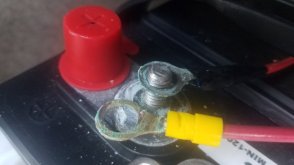I didn't put any goop inside my cable lugs. It never occured to me to do so. My thoughts on this are that a solid cold weld crimp onto a closed end lug, followed by heat shrink tubing (with adhesive) is as good as it gets. If you did it right, this is an air tight bond.
You could take this to an extreme and say that the insulation on the entire length of the wire needs to be removed so you can apply an antioxidant. This would, of course, be silly because the wires between the lugs don't need an antioxidant. And you would never get the insulation off in one piece, let alone get it back on. Yes, I'm being facetious here.
The goop could act as a lubricant, deteriorating the hold the lug has on the cable. This is my only objection. Well, that and it could make a mess as it comes out during crimping. Better wear eye protection!
If ABYC says to use it in lugs, that's a different matter.




